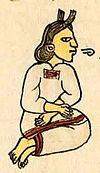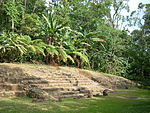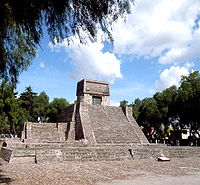Featured articles
Usage
The layout design for these subpages is at Portal:Indigenous peoples of the Americas/Selected article/Layout.
- Add a new Selected article to the next available subpage.
- Update "max=" to new total for its {{Random portal component}} on the main page.
Selected articles list
Portal:Indigenous peoples of the Americas/Selected article/1

Chaco Culture National Historical Park is a United States National Historical Park hosting the densest and most exceptional concentration of pueblos in the American Southwest.The park is located in northwestern New Mexico, between Albuquerque and Farmington, in a remote canyon cut by the Chaco Wash. Containing the most sweeping collection of ancient ruins north of Mexico, the park preserves one of the most important pre-Columbian cultural and historical areas in the United States.
Between AD 900 and 1150, Chaco Canyon was a major center of culture for the Ancient Pueblo Peoples.Chacoans quarried sandstone blocks and hauled timber from great distances, assembling fifteen major complexes that remained the largest buildings in North America until the 19th century.Evidence of archaeoastronomy at Chaco has been proposed, with the "Sun Dagger" petroglyph at Fajada Butte a popular example. Many Chacoan buildings may have been aligned to capture the solar and lunar cycles,requiring generations of astronomical observations and centuries of skillfully coordinated construction Climate change is thought to have led to the emigration of Chacoans and the eventual abandonment of the canyon, beginning with a fifty-year drought commencing in 1130.
Comprising a UNESCO World Heritage Site located in the arid and sparsely populated Four Corners region, the Chacoan cultural sites are fragile – concerns of erosion caused by tourists have led to the closure of Fajada Butte to the public. The sites are considered sacred ancestral homelands by the Hopi and Pueblo people, who maintain oral accounts of their historical migration from Chaco and their spiritual relationship to the land. Though park preservation efforts can conflict with native religious beliefs, tribal representatives work closely with the National Park Service to share their knowledge and respect the heritage of the Chacoan culture.
The park is on the Trails of the Ancients Byway, one of the designated New Mexico Scenic Byways.
Portal:Indigenous peoples of the Americas/Selected article/2

The Maya civilization was a Mesoamerican civilization developed by the Maya peoples, and noted for its hieroglyphic script—the only known fully developed writing system of the pre-Columbian Americas—as well as for its art, architecture, mathematics, calendar, and astronomical system. The Maya civilization developed in an area that encompasses southeastern Mexico, all of Guatemala and Belize, and the western portions of Honduras and El Salvador. This region consists of the northern lowlands encompassing the Yucatán Peninsula, and the highlands of the Sierra Madre, running from the Mexican state of Chiapas, across southern Guatemala and onwards into El Salvador, and the southern lowlands of the Pacific littoral plain. The Archaic period, prior to 2000 BC, saw the first developments in agriculture and the earliest villages. The Preclassic period (c. 2000 BC to 250 AD) saw the establishment of the first complex societies in the Maya region, and the cultivation of the staple crops of the Maya diet, including maize, beans, squashes, and chili peppers. The first Maya cities developed around 750 BC, and by 500 BC these cities possessed monumental architecture, including large temples with elaborate stucco façades. Hieroglyphic writing was being used in the Maya region by the 3rd century BC. In the Late Preclassic a number of large cities developed in the Petén Basin, and Kaminaljuyu rose to prominence in the Guatemalan Highlands. Beginning around 250 AD, the Classic period is largely defined as when the Maya were raising sculpted monuments with Long Count dates. This period saw the Maya civilization develop a large number of city-states linked by a complex trade network. In the Maya Lowlands two great rivals, Tikal and Calakmul, became powerful. The Classic period also saw the intrusive intervention of the central Mexican city of Teotihuacan in Maya dynastic politics. In the 9th century, there was a widespread political collapse in the central Maya region, resulting in internecine warfare, the abandonment of cities, and a northward shift of population. The Postclassic period saw the rise of Chichen Itza in the north, and the expansion of the aggressive K'iche' kingdom in the Guatemalan Highlands. In the 16th century, the Spanish Empire colonised the Mesoamerican region, and a lengthy series of campaigns saw the fall of Nojpetén, the last Maya city in 1697.
Portal:Indigenous peoples of the Americas/Selected article/3

Nahuatl, known historically as Aztec, is a language or group of languages of the Uto-Aztecan language family. Varieties of Nahuatl are spoken by an estimated 1.5 million Nahua peoples, most of whom live in central Mexico. All Nahuan languages are indigenous to Mesoamerica. Nahuatl has been spoken in central Mexico since at least the seventh century CE.It was the language of the Aztecs who dominated what is now central Mexico during the Late Postclassic period of Mesoamerican history. During the centuries preceding the Spanish conquest of the Aztec Empire, the Aztecs had expanded to incorporate a large part of central Mexico, and its influence caused the variety of Nahuatl spoken by the residents of Tenochtitlan to become a prestige language in Mesoamerica. At the conquest, with the introduction of the Latin alphabet, Nahuatl also became a literary language, and many chronicles, grammars, works of poetry, administrative documents and codices were written in it during the 16th and 17th centuries. This early literary language based on the Tenochtitlan variety has been labeled Classical Nahuatl and is among the most studied and best-documented languages of America.
Today, Nahuan languages are spoken in scattered communities, mostly in rural areas throughout central Mexico and along the coastline. There are considerable differences among varieties, and some are mutually unintelligible. Huasteca Nahuatl, with over 1 million speakers, is the most-spoken variety. They have all been subject to varying degrees of influence from Spanish. No modern Nahuan languages are identical to Classical Nahuatl, but those spoken in and around the Valley of Mexico are generally more closely related to it than those on the periphery
Portal:Indigenous peoples of the Americas/Selected article/4

The indigenous people of the Everglades region arrived in the Florida peninsula of what is now the United States approximately 14,000 to 15,000 years ago, probably following large game. The Paleo-Indians found an arid landscape that supported plants and animals adapted to prairie and xeric scrub conditions. Large animals became extinct in Florida around 11,000 years ago. Climate changes 6,500 years ago brought a wetter landscape. The Paleo-Indians slowly adapted to the new conditions. Archaeologists call the cultures that resulted from the adaptations Archaic peoples. They were better suited for environmental changes than their ancestors, and created many tools with the resources they had. Approximately 5,000 years ago, the climate shifted again to cause the regular flooding from Lake Okeechobee that gave rise to the Everglades ecosystems.
From the Archaic peoples, two major tribes emerged in the area: the Calusa and the Tequesta, who were of Taíno origin, an Arawak people, originating from the Caribbean and South America. The earliest written descriptions of these people come from Spanish explorers who sought to convert and conquer them. Although they lived in complex societies, little evidence of their existence remains today. The Calusa were more powerful in number and political structure. Their territory was centered on modern-day Ft. Myers, and extended as far north as Tampa, as far east as Lake Okeechobee, and as far south as the Keys. The Tequesta lived on the southeastern coast of the Florida peninsula around what is today Biscayne Bay and the Miami River. Both societies were well adapted to live in the various ecosystems of the Everglades regions. They often traveled through the heart of the Everglades, though they rarely lived within it.
Portal:Indigenous peoples of the Americas/Selected article/5

Tak'alik Ab'aj is a pre-Columbian archaeological site in Guatemala. It was formerly known as Abaj Takalik; its ancient name may have been Kooja. It is one of several Mesoamerican sites with both Olmec and Maya features. The site flourished in the Preclassic and Classic periods, from the 9th century BC through to at least the 10th century AD, and was an important centre of commerce,trading with Kaminaljuyu and Chocolá. Investigations have revealed that it is one of the largest sites with sculptured monuments on the Pacific coastal plain.Olmec-style sculptures include a possible colossal head, petroglyphs and others. The site has one of the greatest concentrations of Olmec-style sculpture outside of the Gulf of Mexico.
Takalik Abaj is representative of the first blossoming of Maya culture that had occurred by about 400 BC. The site includes a Maya royal tomb and examples of Maya hieroglyphic inscriptions that are among the earliest from the Maya region. Excavation is continuing at the site; the monumental architecture and persistent tradition of sculpture in a variety of styles suggest the site was of some importance.
Finds from the site indicate contact with the distant metropolis of Teotihuacan in the Valley of Mexico and imply that Takalik Abaj was conquered by it or its allies.Takalik Abaj was linked to long-distance Maya trade routes that shifted over time but allowed the city to participate in a trade network that included the Guatemalan highlands and the Pacific coastal plain from Mexico to El Salvador.
Portal:Indigenous peoples of the Americas/Selected article/6

The Mayan languages form a language family spoken in Mesoamerica and northern Central America. Mayan languages are spoken by at least 6 million Maya peoples, primarily in Guatemala, Mexico, Belize and Honduras. In 1996, Guatemala formally recognized 21 Mayan languages by name,and Mexico recognizes eight more within their territory.
The Mayan language family is one of the best-documented and most studied in the Americas.Modern Mayan languages descend from the Proto-Mayan language, thought to have been spoken at least 5000 years ago; it has been partially reconstructed using the comparative method. The proto-Mayan language diversified into at least 6 different branches, the Huastecan, Quichean, Yucatecan, Qanjobalan, Mamean and Ch'olan-Tzeltalan branches.
Mayan languages form part of the Mesoamerican language area, an area of linguistic convergence developed throughout millennia of interaction between the peoples of Mesoamerica. All Mayan languages display the basic diagnostic traits of this linguistic area. For example, all use relational nouns instead of prepositions to indicate spatial relationships. They also possess grammatical and typological features that set them apart from other languages of Mesoamerica, such as the use of ergativity in the grammatical treatment of verbs and their subjects and objects, specific inflectional categories on verbs, and a special word class of "positionals" which is typical of all Mayan languages.
Portal:Indigenous peoples of the Americas/Selected article/7

The Kiowa /ˈkaɪ.oʊwə/ are a nation of American Indians of the Great Plains. They migrated from western Montana southward into the Rocky Mountains in Colorado in the 17th and 18th centuries, In 1867, the Kiowa moved to a reservation in southwestern Oklahoma.
Today they are federally recognized as Kiowa Tribe of Oklahoma with headquarters in Carnegie, Oklahoma. The Kiowa language is still spoken today and is part of the Tanoan language family. As of 2011[update], there are 12,000 members.
Kiowa call themselves Ka'igwu, meaning "Principal People". Ancient names were Kwu-da and Tep-da, relating to the myth pulling or coming out of a hollow log until a pregnant woman got stuck. Later, they called themselves Kom-pa-bianta for "people with large tipi flaps", before they met Southern Plains tribes or before they met white men. Another explanation of their name "Kiowa" originated after their migration through what the Kiowa refer to as "The Mountains of the Kiowa" (Kaui-kope) in the present eastern edge of Glacier National Park, Montana, just south of the border with Canada.
Portal:Indigenous peoples of the Americas/Selected article/8

The Arapaho (in French: Arapahos, Gens de Vache) are a tribe of Native Americans historically living on the plains of Colorado and Wyoming. They were close allies of the Cheyenne tribe and loosely aligned with the Lakota and Dakota. The Arapaho language, Heenetiit, is an Algonquian language closely related to Gros Ventre (Ahe/A'ananin), whose people are seen as an early offshoot of the Arapaho. Blackfeet and Cheyenne are the other Algonquian-speakers on the Plains, but their languages are quite different from Arapaho.
By the 1850s, Arapaho bands formed two tribes: the Northern Arapaho and Southern Arapaho. Since 1878 the Northern Arapaho have lived with the Eastern Shoshone on the Wind River Reservation in Wyoming and are federally recognized as the Arapahoe Tribe of the Wind River Reservation. The Southern Arapaho live with the Southern Cheyenne in Oklahoma. Together their members are enrolled as the federally recognized Cheyenne and Arapaho Tribes.
Portal:Indigenous peoples of the Americas/Selected article/9

Ohlone people, also known as the Costanoan, are a Native American people of the central and northern California coast. When Spanish explorers and missionaries arrived in the late 18th century, the Ohlone inhabited the area along the coast from San Francisco Bay through Monterey Bay to the lower Salinas Valley. At that time they spoke a variety of languages, the Ohlone languages, belonging to the Costanoan sub-family of the Utian language family, which itself belongs to the proposed Penutian language phylum. The term "Ohlone" has been used in place of "Costanoan" since the 1970s by some descendant groups and by most ethnographers, historians, and writers of popular literature. In pre-colonial times, the Ohlone lived in more than 50 distinct landholding groups, and did not view themselves as a distinct group. They lived by hunting, fishing, and gathering, in the typical ethnographic California pattern. The members of these various bands interacted freely with one another as they built friendships and marriages, traded tools and other necessities, and partook in cultural practices. The Ohlone people practiced the Kuksu religion. Before the Spanish came, the northern California region was one of the most densely populated regions north of Mexico. However in the years 1769 to 1833, the Spanish missions in California had a devastating effect on Ohlone culture. The Ohlone population declined steeply during this period.
Portal:Indigenous peoples of the Americas/Selected article/10

The Aztec /ˈæztɛk/ people were certain ethnic groups of central Mexico, particularly those groups who spoke the Nahuatl language and who dominated large parts of Mesoamerica from the 14th to 16th centuries. The Nahuatl words aztecatl [asˈtekat͡ɬ] (singular) and aztecah [asˈtekaʔ] (plural) mean "people from Aztlán", a mythological place for the Nahuatl-speaking culture of the time, and later adopted as the word to define the Mexica people. Often the term "Aztec" refers exclusively to the Mexica people of Tenochtitlan (now the location of Mexico City), situated on an island in Lake Texcoco, who referred to themselves as Mēxihcah Tenochcah [meːˈʃiʔkaʔ teˈnot͡ʃkaʔ] or Cōlhuah Mexihcah [ˈkoːlwaʔ meːˈʃiʔkaʔ].
Sometimes the term also includes the inhabitants of Tenochtitlan's two principal allied city-states, the Acolhuas of Texcoco and the Tepanecs of Tlacopan, who together with the Mexica formed the Aztec Triple Alliance which controlled what is often known as the "Aztec Empire". In other contexts, Aztec may refer to all the various city states and their peoples, who shared large parts of their ethnic history and cultural traits with the Mexica, Acolhua and Tepanecs, and who often also used the Nahuatl language as a lingua franca. In this meaning it is possible to talk about an Aztec civilization including all the particular cultural patterns common for most of the peoples inhabiting Central Mexico in the late postclassic period.
Nominations
Feel free to add Indigenous peoples of the Americas related articles Featured articles to the above list.